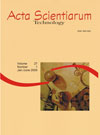Simulation and analysis of an industrial system of columns for ethanol distillation
DOI:
https://doi.org/10.4025/actascitechnol.v29i1.81Keywords:
destilação, álcool etílico hidratado, simulador de processosAbstract
A typical industrial system of distillation columns involves three columns for hydrated ethyl alcohol production. In order to obtain a better understanding of the behavior of this system, several sample points were installed along the distillation unit for measuring temperature, pressure and flow values, and also for collecting liquid phase samples in order to determine the corresponding alcoholic concentrations. The distillation unit involves three rectification and stripping columns. The experimental measurements made possible the evaluation of the quality of the process simulation results. The simulation results indicate that, among the equations available in process simulation for calculating the activity coefficients, the NRTL model was the one that leads to the best agreement with the experimental data, with deviations around 2 and 2.5% in relation to temperatures and alcohol concentrations respectively, whose values were measured in several trays of the distillation unit.Downloads
Download data is not yet available.
Downloads
Published
2007-12-18
How to Cite
Marquini, M. F., Mariani, D. C., Meirelles, A. J. de A., Santos, O. A. A. dos, & Jorge, L. M. de M. (2007). Simulation and analysis of an industrial system of columns for ethanol distillation. Acta Scientiarum. Technology, 29(1), 23–28. https://doi.org/10.4025/actascitechnol.v29i1.81
Issue
Section
Chemical Engineering
License
DECLARATION OF ORIGINALITY AND COPYRIGHTS
I Declare that current article is original and has not been submitted for publication, in part or in whole, to any other national or international journal.
The copyrights belong exclusively to the authors. Published content is licensed under Creative Commons Attribution 4.0 (CC BY 4.0) guidelines, which allows sharing (copy and distribution of the material in any medium or format) and adaptation (remix, transform, and build upon the material) for any purpose, even commercially, under the terms of attribution.
Read this link for further information on how to use CC BY 4.0 properly.











8.png)




